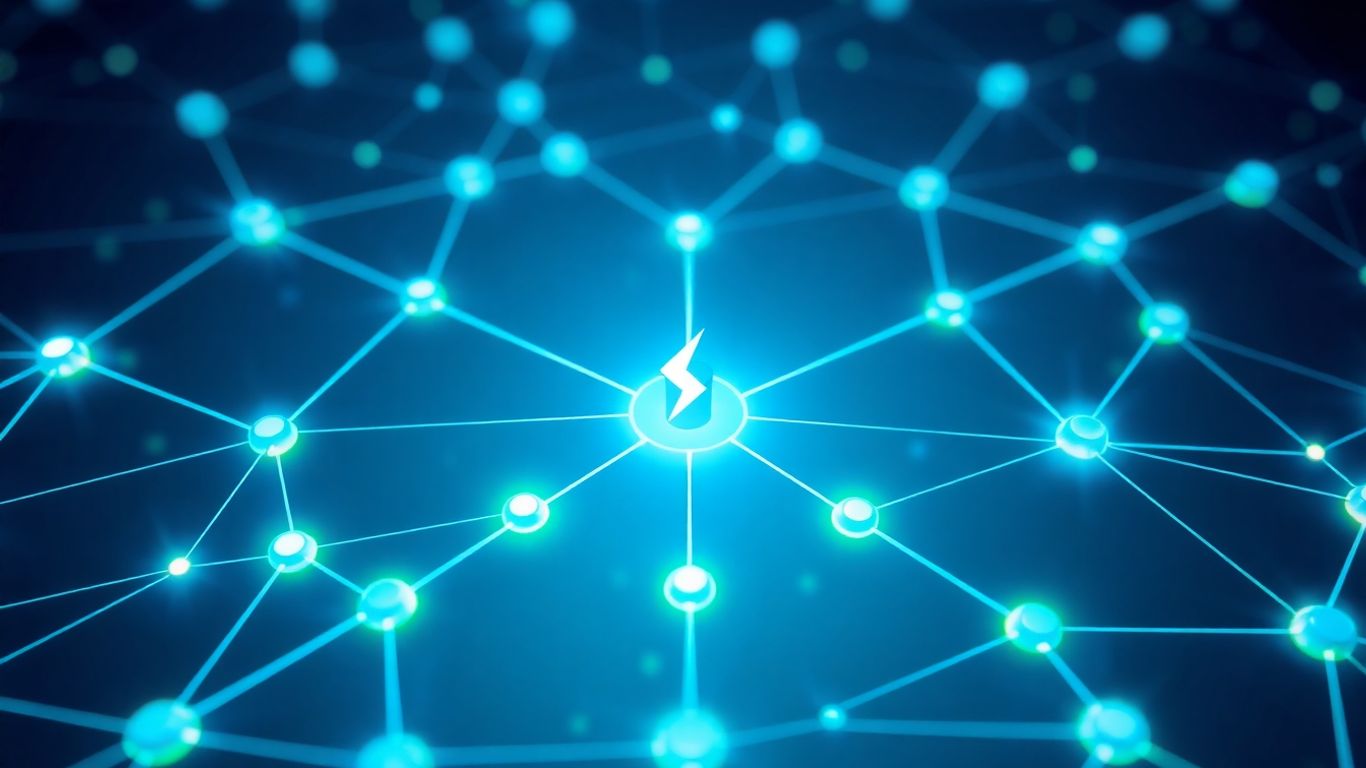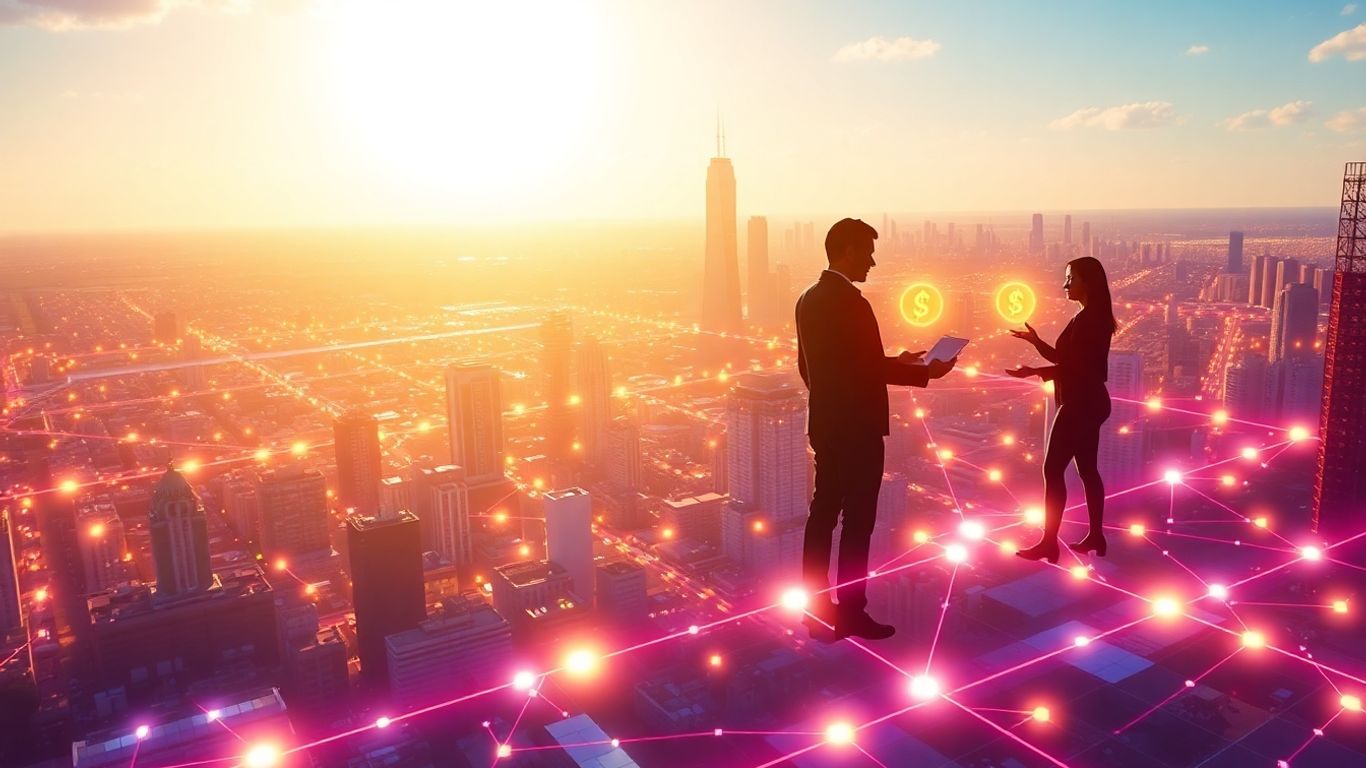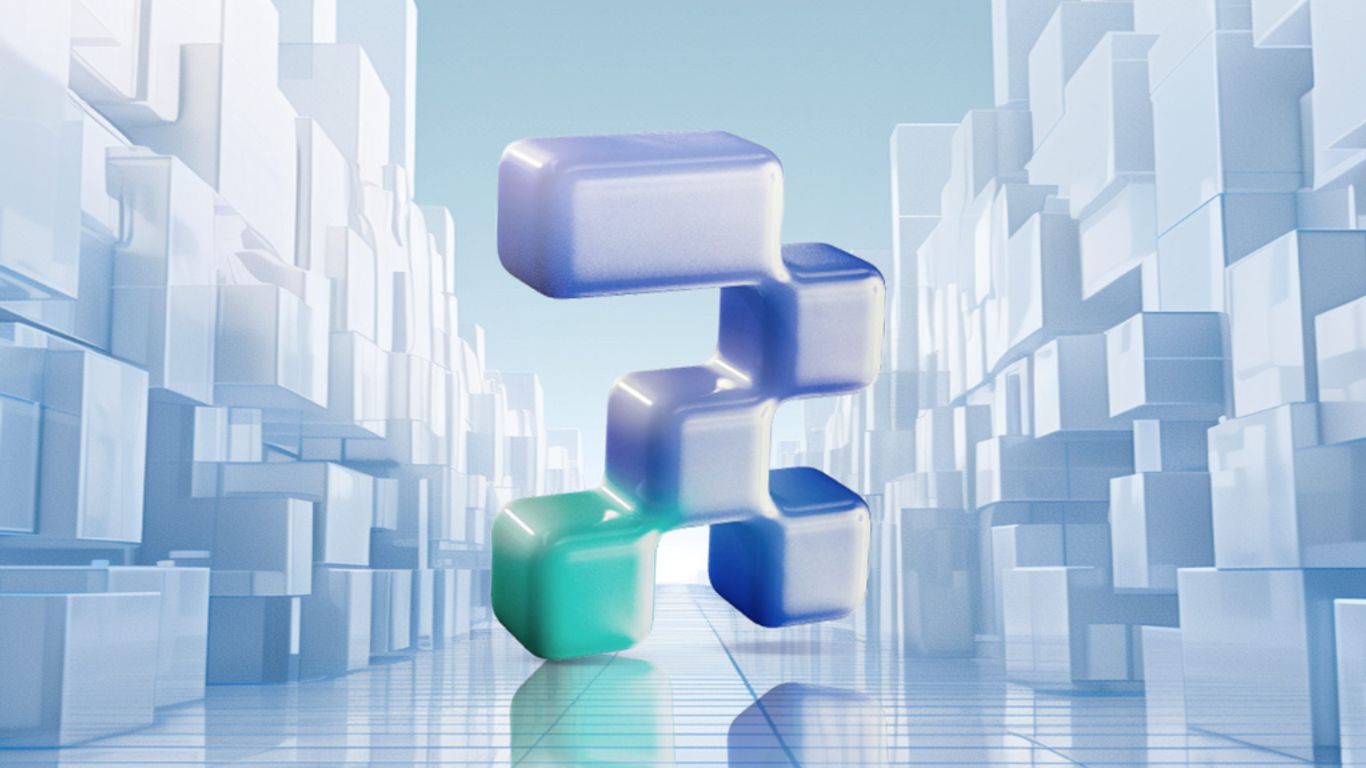It feels like every day there's a new buzzword about how we're going to fix the energy grid. Lately, a lot of talk is about blockchain. You might think of Bitcoin, but it turns out this tech could actually change how we buy and sell energy. We're talking about something called tokenized energy credits, and it's pretty interesting stuff. It could make things fairer for everyone, from the folks making power to the ones using it. Let's break down what this means.
Key Takeaways
- Blockchain technology can make energy trading more transparent and secure by using a shared, unchangeable record of transactions.
- Smart contracts automate buying and selling energy, cutting down on costs and speeding up how quickly payments happen.
- Tokenized energy credits give consumers more say in where their energy comes from and let producers sell extra power.
- Projects like microgrids and efforts by big energy companies show that trading tokenized energy credits is already happening.
- While there are challenges like rules and security, blockchain offers a path to a more efficient and sustainable energy future.
Understanding Tokenized Energy Credits
The Role of Blockchain in Energy Markets
Think about energy credits like little digital certificates that prove you've done something good for the environment, like reducing your carbon footprint or generating clean energy. Traditionally, trading these credits could be a bit of a headache – lots of paperwork, slow processes, and sometimes, it wasn't super clear who owned what or if the credits were even legit. That's where blockchain comes in. It's like a super secure, shared digital ledger that records every single transaction. This makes it way easier to track energy credits from the moment they're created all the way to when they're used. It cuts out a lot of the middleman stuff, which can make things faster and cheaper.
Decentralized Grids and Peer-to-Peer Trading
With blockchain, we're seeing a shift towards more decentralized energy systems. Imagine a neighborhood where houses with solar panels can sell their extra electricity directly to their neighbors, without needing a big utility company in the middle. Blockchain makes this kind of peer-to-peer trading possible. Energy credits can be tokenized, meaning they become digital assets on the blockchain. These tokens can then be traded directly between individuals or businesses. This opens up new possibilities for how we buy and sell energy, making the whole system more flexible and community-focused.
Here's a simplified look at how it works:
- Generation: Clean energy is produced (e.g., solar, wind).
- Verification: The amount of clean energy is verified and recorded.
- Tokenization: Verified energy credits are turned into digital tokens on a blockchain.
- Trading: These tokens can be bought and sold between parties.
- Retirement: Tokens are used (retired) to offset emissions or claim benefits, and this action is recorded permanently.
Enhancing Transparency and Security
One of the biggest wins with blockchain is the transparency it brings. Because every transaction is recorded on an immutable ledger, it's incredibly difficult to tamper with. This means you can be much more confident about the origin and ownership of energy credits. No more worrying about double-counting or fraudulent credits. It creates a trustworthy system where everyone can see what's happening, reducing the risk of errors and making the whole market more reliable. It's like having a public notary for every energy credit transaction, but way more efficient.
The core idea is to take something valuable, like a verified unit of clean energy production, and represent it as a digital token. This token can then be managed and traded using blockchain technology, which provides a secure and transparent way to handle these transactions. It's about making the process of trading environmental benefits more straightforward and trustworthy for everyone involved.
The Mechanics of Tokenized Energy Credits

So, how does this whole token thing actually work when we're talking about energy credits? It's not just magic, there's a process. Think of it like turning a paper certificate into a digital asset that lives on a computer network. This makes it way easier to trade and keep track of.
Smart Contracts for Automated Transactions
This is where the "smart" in smart contracts comes in. These are basically computer programs that live on the blockchain. They automatically do things when certain conditions are met. For energy credits, this means things like:
- Automatic Transfer: When someone buys an energy credit token, the smart contract can automatically send the token to their digital wallet and take the payment from their account. No need for a person to manually approve every single step.
- Settlement: Once a trade is agreed upon, the smart contract handles the exchange of tokens for payment. This happens really fast, often in minutes.
- Retiring Credits: If a company uses a token to offset their emissions, the smart contract can automatically mark that token as "used" or "retired" on the blockchain. This stops anyone from trying to use the same credit twice.
The whole point is to make transactions happen without needing a middleman, which saves time and cuts down on mistakes.
Immutable Ledgers for Auditable Records
Remember how I said blockchain is like a shared digital notebook? That's the "immutable ledger" part. Once something is written down on the blockchain, it's pretty much there forever and can't be changed. This is a big deal for energy credits because:
- Proof of Ownership: Every time an energy credit token changes hands, it's recorded. You can always look back and see who owned what and when.
- Preventing Fraud: Because the records can't be altered, it's much harder for someone to fake a credit or claim they own something they don't.
- Easy Auditing: If someone needs to check where the credits came from or where they went, they can just look at the blockchain. It's all there, clear as day.
This transparency means everyone involved can trust the system more. You don't have to just take someone's word for it; the blockchain provides the proof.
Reducing Transaction Costs and Settlement Times
Before blockchain, trading energy credits could involve a lot of paperwork, fees, and waiting. Think about all the banks, brokers, and clearinghouses involved. Tokenization cuts through a lot of that.
- Fewer Intermediaries: Smart contracts handle a lot of the work that people used to do, so you don't need as many people or companies in the middle.
- Faster Settlements: Trades can be completed almost instantly, rather than waiting days or weeks for everything to clear.
- Lower Fees: With fewer middlemen and automated processes, the fees associated with each transaction go down. This makes it cheaper for everyone involved.
It's like going from sending a letter by snail mail to sending an instant message. The end result is the same, but the journey is way quicker and cheaper.
Benefits for Energy Consumers and Producers

So, what's in it for the folks actually using and making the energy? Turns out, quite a bit. Tokenizing energy credits on a blockchain really shakes things up, giving both consumers and producers more say and more chances to benefit.
Increased Control Over Energy Sources
Think about it: you're not just a passive recipient of whatever power the utility company sends your way anymore. With tokenized credits, you can actually choose where your energy comes from. If you want to support local solar farms or a wind project down the road, you can do that. This means you can align your energy use with your values, maybe opting for cleaner sources or supporting community energy initiatives. It's a big shift from the old model where your choices were pretty limited. You get to see the options and pick what works best for you, which is pretty neat.
Opportunities for Financial Profit from Surplus Energy
This is where things get really interesting, especially for people with solar panels or other ways of generating their own power. If you're producing more energy than you need, instead of just letting it go to waste, you can sell that surplus. Tokenized credits make this process way simpler. You can trade your extra energy directly with neighbors or other users on the network. This opens up a whole new avenue for making money from your own energy production. It's not just about saving money on your bill anymore; it's about actively participating in the energy market and potentially earning a profit. Imagine your rooftop solar not only powering your home but also putting cash back in your pocket.
Empowering Prosumers in the Energy Ecosystem
We're seeing a rise in what are called 'prosumers' – people who are both producers and consumers of energy. Blockchain technology is a game-changer for these individuals. It gives them the tools to manage their energy generation, track their usage, and trade their excess power all in one place. This creates a more dynamic and participatory energy landscape. Instead of being just a number on a utility bill, you become an active player in the energy grid. This shift can lead to more stable local grids and a more efficient overall energy system. It's about giving power back to the people, literally.
Here's a quick look at how this plays out:
- Direct Trading: Sell excess energy directly to neighbors or businesses.
- Price Transparency: See real-time energy prices and make informed trading decisions.
- Grid Stability: Contribute to a more balanced and resilient local energy grid.
The old way of doing things often left individuals with little say in their energy consumption or production. Tokenized energy credits, powered by blockchain, are changing that narrative. They're creating a system where individuals have more agency, can benefit financially from their energy assets, and play a more active role in the energy transition. It's a move towards a more democratic and efficient energy future for everyone involved.
Real-World Applications and Case Studies
So, where is this blockchain energy trading actually happening? It's not just a futuristic idea anymore. We're seeing some really interesting projects pop up, showing how this tech can work in practice.
Microgrid Projects and Localized Energy Trading
Think about a neighborhood or a small community. Instead of relying solely on the big power company, they can create their own mini-grid. Blockchain makes it possible for homes with solar panels to sell their extra electricity directly to their neighbors. This is a big deal for local energy independence. One notable example is a project in Brooklyn where a microgrid was set up. The utility company still manages the main grid, but residents can produce, trade, and use energy amongst themselves. This creates what we call 'prosumers' – people who both consume and produce energy.
- Brooklyn Microgrid: A pilot project demonstrating peer-to-peer energy trading within a community. This showed how neighbors could buy and sell solar power directly.
- Smart Meter Integration: These systems rely on smart meters to accurately track energy generation and consumption, feeding that data into the blockchain.
- Automated Transactions: Smart contracts handle the buying and selling automatically, making it easy for participants.
These localized systems are a glimpse into a future where energy is more distributed and community-focused.
Adoption by Traditional Energy Companies
It's not just the small startups getting involved. Even the big, established energy players are looking into blockchain. They see how it can help with tracking things like Renewable Energy Certificates (RECs). A REC is basically a certificate that proves one megawatt-hour of electricity was generated from a renewable source. Blockchain can make tracking these certificates much more transparent and secure. This is important for companies trying to meet green energy goals. For instance, blockchain can help improve data transparency in the oil and gas sector, making transactions more efficient and reducing costs.
Pioneering Nations in Blockchain Energy Trading
Some countries are really pushing the envelope when it comes to new energy trading methods. Australia is often mentioned as a leader in renewable energy tech and peer-to-peer trading. But it's not the only one. Countries like Estonia, Spain, Malaysia, the United States, and South Africa are all exploring and implementing blockchain for energy transactions. These places are actively researching and applying these new forms of energy trading, showing a global interest in blockchain's role in sustainability.
Addressing Challenges in Tokenized Energy Credit Systems
Okay, so we've talked a lot about how cool tokenized energy credits can be, right? But it's not all sunshine and perfectly balanced grids. There are definitely some bumps in the road we need to smooth out before this becomes as common as, well, turning on a light switch.
Navigating Regulatory Hurdles
This is a big one. Right now, the rules for this stuff are kind of all over the place. Different countries, and even different states or provinces, have their own ideas about how energy trading should work, and they haven't quite caught up with blockchain yet. It's like trying to play a game where the rules keep changing. We need clear guidelines so everyone knows what's what, and so these tokens are actually recognized and trusted.
- Lack of standardized frameworks: There isn't a universal set of rules for tokenizing energy credits, leading to confusion.
- Jurisdictional complexities: Energy markets are often regional, but blockchain is global, creating a mismatch.
- Classification uncertainty: Are these tokens considered securities, commodities, or something else entirely? The answer affects how they're regulated.
The biggest hurdle is getting old-school regulators to understand and accept new-school technology. It takes time, and a lot of education, for everyone to feel comfortable with the changes.
Overcoming Security Concerns and Potential Hacks
While blockchain is known for security, it's not completely foolproof. Think about it: if the system holding all these valuable energy credits gets compromised, that's a major problem. We're talking about the potential for fraud, like someone trying to sell the same credit twice, or even outright theft of tokens. Keeping the digital vault secure is paramount.
- Smart contract vulnerabilities: Bugs in the code can be exploited by bad actors.
- Private key management: If users lose their private keys, they lose access to their tokens forever.
- Phishing and social engineering: Attackers might try to trick people into giving up their login information.
Adapting Business Models for a Decentralized Future
This is where the established energy companies might feel a bit uneasy. Their whole business has been built on a centralized model for decades. Suddenly, you have individuals and small groups trading energy directly. This means big companies need to rethink how they operate, how they make money, and how they fit into this new, more distributed landscape. It's a shift from being the sole provider to being a participant in a larger network.
- Shifting revenue streams: Companies might need to move from selling energy to providing services like grid management or platform access.
- Interoperability challenges: Making sure new tokenized systems can talk to existing, older infrastructure is tricky.
- Educating stakeholders: Getting employees, investors, and customers on board with the new way of doing things takes effort.
The Future of Energy Trading with Blockchain
So, what's next for energy trading now that blockchain is in the picture? It's not just about making current systems a bit better; it's about rethinking how we handle energy altogether. We're looking at a future where energy grids are way more flexible and responsive. Think about grids that can adjust almost instantly to changes in supply and demand, making everything run smoother and cutting down on waste. This shift is paving the way for what's called "transactive energy frameworks." These are basically systems that allow for the automated, real-time buying and selling of energy, often using those smart contracts we talked about earlier.
The Evolution of Transactive Energy Frameworks
These frameworks are really the backbone of a more dynamic energy market. They're designed to make energy trading more efficient and accessible. Here's a quick look at what that means:
- Automated Transactions: Smart contracts handle the buying and selling automatically, based on pre-set rules. No more manual paperwork or waiting around for approvals.
- Real-Time Pricing: Energy prices can change by the minute, reflecting actual supply and demand. This means consumers can buy power when it's cheapest, and producers get paid fairly for what they generate.
- Decentralized Control: Instead of one central authority calling all the shots, control is spread out. This makes the whole system more resilient.
The move towards transactive energy isn't just a tech upgrade; it's a fundamental change in how we think about energy as a commodity and a service. It's about creating a more intelligent and interconnected energy landscape.
Integration with Distributed Energy Resources
This is where things get really interesting for homeowners and businesses with solar panels or other renewable sources. Blockchain makes it much easier to connect these smaller energy producers, often called "prosumers," directly into the grid. Instead of just using the energy they generate, they can easily sell their surplus back to their neighbors or the wider grid. This is a big deal for making our energy sources more diverse and less reliant on big, old power plants. It's all about making better use of the energy we can generate locally, which is a key part of building a more sustainable future. You can see how this ties into the broader goal of a smarter and greener energy future.
Driving Environmental Sustainability and Efficiency
Ultimately, all these changes are aimed at making our energy system better for the planet. By making energy trading more efficient and transparent, we can reduce waste and encourage the use of renewable energy. When people can easily sell their excess solar power, they're more likely to invest in solar in the first place. This creates a positive feedback loop that drives down carbon emissions and makes our energy use more responsible. It's a complex puzzle, but blockchain seems to be a pretty important piece in putting it all together.
Wrapping It Up
So, we've looked at how blockchain can really shake things up in the energy world. It's not just about fancy tech; it's about making energy trading simpler, cheaper, and more open. Think about local energy sharing, cutting down on waste, and even helping the planet a bit more. While there are still some hurdles, like figuring out the rules and making sure the tech works smoothly for everyone, the potential is pretty big. It feels like we're on the edge of seeing some real changes in how we get and use power, and blockchain is definitely a key player in that story.
Frequently Asked Questions
What are energy credits and how does blockchain help?
Think of energy credits like tickets that show you've used or produced a certain amount of clean energy. Blockchain is like a super secure digital notebook that keeps track of these tickets. It makes sure no one cheats, everyone knows who owns what, and the records can't be easily changed. This makes trading these energy tickets fair and clear for everyone involved.
Can I sell my extra solar power to my neighbors using blockchain?
Yes, that's the idea! If you have solar panels and make more electricity than you need, blockchain can help you sell that extra power directly to your neighbors. This is called peer-to-peer trading, and blockchain makes it safe and easy to manage who gets paid for their energy.
Is it hard to use blockchain for energy trading?
It might sound complicated, but the goal is to make it simpler. Blockchain uses 'smart contracts,' which are like automatic agreements. When one person agrees to buy energy from another, the smart contract handles the payment and delivery automatically, without needing lots of paperwork or middlemen.
Are there any risks with using blockchain for energy?
While blockchain is very secure, like any technology, it's not impossible to hack. People are working hard to make it even safer. Also, governments are still figuring out the rules for this new way of trading energy, which can sometimes slow things down.
Who benefits from trading energy with blockchain?
Everyone can benefit! People who make their own clean energy, like those with solar panels, can earn money by selling extra power. Energy companies can become more efficient and transparent. And consumers might get cleaner energy at a better price because the system is more direct and less wasteful.
Is this just a future idea, or is it happening now?
It's happening now! There are already projects around the world testing and using blockchain for energy trading. Some neighborhoods have set up 'microgrids' where people trade energy directly, and even big energy companies are starting to explore how they can use this technology.




